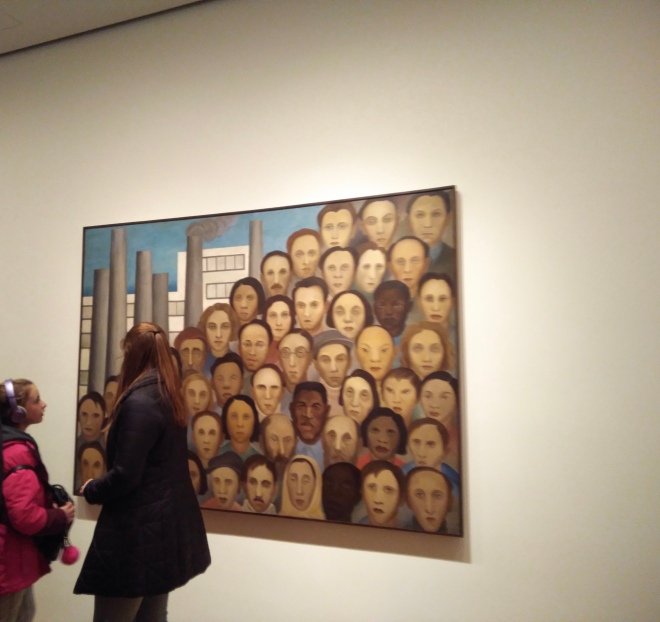Umas crianças dos 7 a 9 anos, obviamente parte de uma turma escolar, se sentaram no chão em frente do quadro “Composição (Figura Só)” da grande artista brasileira, Tarsila do Amaral. Sua professora lhes dava instruções sobre o que fazer com seus cadernos de desenho. Que lindo ver aqueles meninos tendo uma aula de arte no MOMA! (Museum of Modern Art, NYC)

Dentro das salas lotadas, não somente circulavam alunos de todas as idades, mas também, idosos, adultos, brasileiros, americanos dos Estados Unidos, e turistas de vários países. A obra da artista brasileira, Tarsila, finalmente chegou ao MOMA de Nova Iorque!

Eu vi algumas das peças dela em São Paulo em 2014. Gostei muito dos museus de São Paulo, MASP e as Pinotecas. Eu fui em uma quarta-feira, no 28 de março de 2018, para vivienciá-la em Nova Iorque. O MOMA e o Chicago Art Institute colaboraram para fazer esta iniciativa. Especificamente, Luis Pérez-Oramas e Stephanie D’Alessandro prepararam e organizaram a exposição, com ajuda de Karen Grimson.

O que mais gostei desta exposicão foi a oportunidade de ver a sua obra original na minha frente e ao mesmo tempo reviver meus momentos no Brasil. Cada quadro de Tarsila invoca um aspeto da cultura brasileira, e inspira a saudade. E isso o que ela queria, porque quando estava fora do Brasil, começou a sentir-se ainda mais brasileira e disse:

Uma coisa que não entendo (e não gosto) de alguns museus, é o monolinguismo. E não é só MOMA que faz isso. Para esta mostra de arte, todas as inscrições (menos os títulos das obras) e a áudio-guia foram apresentadas em inglês. Claro, este evento se destina ao público estadunidense, mas na minha opinião, deve ser bilingue–em português e inglês. Existem certas coisas que resistem a tradução e é ilucinante ter o original no lugar para referência, e uma explicação em português (ou a língua do artista). Na áudia-guia que eu segui em inglês, tinha um erro com a pronúncia de “Sono” (disse “sonho” que significa “dream” em inglês) que realmente confundaria todo o significado da obra “O Sono” de Tarsila. Outra vantagem do bilinguismo é que acolhe a mais pessoas. Uma apresentação bilingue daria o “bem-vindo” aos lusofalantes a uma exposição de muita importância para o Brasil e o mundo lusófono.
Porém, é uma crítica menor. Adorei reparar sua obra desde os desenhos de lápiz e tinta em papel até os grandes quadros à óleo, pelos quais ganhou sua fama no Brasil e no exterior.

Não vou fazer uma crítica “objetiva” ou escrever um texto pseudo-acadêmico sobre Tarsila no MOMA. Já publicaram a guia que todos podem comprar na livraria. Também podem assistir à entrevista com Caetano Veloso que fizeram no museu, sobre a arte de Tarsila e o tropicalismo em youtube.com, ou até podem fazer uma busca de Google para os artigos escritos por expertos famosos de arte. Prefiro oferecer algumas das minha reações e observações sobre meus quadros favoritos da exposição.
Primeiro, como artista, admirei muito que Tarsila assinasse seus quadros com apenas seu primeiro nome. Existe a ideia entre alguns artistas estadunidenses que um artista plástico “sério” tem que assinar sua obra com o sobrenome. Tarsila mostra que isso não é verdade.
Tarsila pintou temas brasileiros e iniciou, com seu esposo Oswald de Andrade, e outros artistas de todo tipo, o movimento antropófago e modernismo em São Paulo. Tarsila viajou para París para estudar arte, e também pelo Brasil para explorar temática autóctone. Ela desenhou e pintou animais, figuras humanas, “quase” humanas, a natureza, o campo e a cidade. Sobretudo em uma maneira não realista. Tinha influência de cubismo, surrealismo, futurismo e tudo que estava se fazendo naquela época–nas primeiras três décadas do século XX.
Nascida em 1886, em uma fazenda de São Paulo, capta a natureza de forma bruta na sua obra. “Cartão postal” de Tarsila tem os elementos de muitos postais típicos do Brasil–palmeiras, outras árvores, animais, casas, fruta, água e morros. É interesante sua mistura de plantas da caatinga com o rio/mar–como se este cartão postal representasse não só a familiar paisagem tropical, mas também a do interior, do sertão brasileiro.

“O sono” fica na minha cabeça, por seu surrealismo misturado com o elemento brasileiro–essa palmeira primitiva e essencial.

A última obra que se encontra antes de terminar e sair da sala é “Operários” de 1933. Aquí tem uma representação de tipos de brasileiros diferentes e as usinas urbanas.

Tarsila do Amaral: Inventing Modern Art in Brazil continua no MOMA até 3 de junho 2018.



